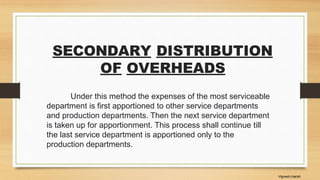
COST AND MANAGMENT for accountancy for college students in basic level
- 1. SECONDARY DISTRIBUTION OF OVERHEADS Under this method the expenses of the most serviceable department is first apportioned to other service departments and production departments. Then the next service department is taken up for apportionment. This process shall continue till the last service department is apportioned only to the production departments. Vignesh,Harish
- 3. Absorption of Overheads • Overhead absorption is the amount of indirect costs assigned to cost objects. Indirect costs are costs that are not directly traceable to an activity or product. Cost objects are items for which costs are compiled, such as products, product lines, customers, retail stores, and distribution channels. Vignesh,Harish
- 4. Types of Overhead rate 1.Percentage Of Direct Material Cost 2.Percentage of Direct Labour Cost 3.Percentage of Prime Cost 4.Direct Labour Cost 5.Machine Hour Rate 6. Rate Per Unit Of Production Vignesh,Harish
- 5. Methods of absorption overhead • #1 – Direct Material Cost Method • Here the direct material cost serves as the basis of absorption. It is calculated by the formula given below. This method is suitable when the material price does not vary a lot or where material cost forms the major cost component. Vignesh,Harish
- 6. #2 – Direct Labor Cost Method • Here the direct labor cost serves as the basis of absorption. It is calculated by the formula given below. This method is suitable when wages do not vary significantly or where direct wages form the major cost component.Also, this method is applied when there is efficiency and productivity in the workforce. • Direct Labor Percentage Rate = (Factory Overhead /Direct Wages) * 100 Vignesh,Harish
- 7. #3 – Prime Cost Percentage Method • Here the overhead is divided by the department’s direct material and direct labor costs. This method is simple and easy to calculate. The formula for the same is as below: • Prime Cost Percentage Rate = (Factory Overhead / Prime Cost) * 100 Vignesh,Harish
- 8. #4 – Direct Labor Hour Method • This is calculated by dividing the factory overhead by direct labor hours. This method is best for cases when production is carried out manually or even for cases where production is not uniform. The formula is as follows: • Labor Hour Rate = Factory Overhead / Labor Hours Vignesh,Harish
- 9. #5 – Machine Hour Rate Method • This applies to those industries where the manual job is negligible and machines are extensively used for production. The formula goes as follows: • Machine Hour Rate = Factory Overhead / Machine Hours Vignesh,Harish
- 10. #6 – Rate per Unit Production Method • This is used in industries where the output is measured in physical units like weight or some numbers. This is applicable in cases where only one type of product is being produced and production is uniform. The formula for the same is as follows: • Overhead Absorption Rate per Unit = Factory Overhead / Units of Production Vignesh,Harish
- 11. #7 – Sales Price Method • Under this method, the overhead budget is divided by the sales price per production unit. The formula for the same is as follows: • Sales Price Recovery Rate = (Factory Overhead / Sales Value Unit of Production) * 100 Vignesh,Harish
- 12. machine hour rate method • Machine hour rate is called as service hour method. In this method, active hours of machine are taken into account for calculation of depreciation. This method is commonly used in sectors like chemicals, steel and other heavy industries. • In this method, machine hour rate is established and charged to production. Machine hour rate means the amount spent on machine to run for an hour. Vignesh,Harish
- 13. computation of machine hour rate • The machine hour rate is computed to recover or absorb factory overheads. • This basis for the recovery of overheads is adopted in industrial concerns where most of the work is driven by machines. In these companies, most of the factory expenses result from machine operations. • To compute the machine hour rate, each machine or a group of similar machines in a production department is considered a smaller department, and departmental expenses are re-apportioned to the machines or groups of machines in the department. Vignesh,Harish
- 14. (i) Base Period A base period is taken for every machine to compute the machine hour rate. This base period is the period for which the hourly rate is to be computed (it may be a year, quarter, month, or week). (ii) Normal Hours of Working The number of normal or standard working hours of each machine in the base period has to be estimated. (iii) Distribution of Expenses The departmental expenses to be considered when calculating the machine hour rate are divided into two parts: •Standing charges (or fixed expenses) •Running charges (or variable expenses or machine expenses) Standing Charges Standing charges include all the expenses that remain fixed or constant, and which relate to the department as a whole. These are not affected by the operation of the machines. Examples of standing charges include rent, rates, and insurance for the factory building, the cost of factory supervision, factory lighting, and machine insurance. Running Charges Running charges include the expenses that are incurred in connection with the operation of the machines (e.g., depreciation, repairs, and maintenance, as well as power, steam, and water use charges). (iv) Calculating the Hourly Rate of Standing Charges To compute the machine hour rate, all standing charges relating to the production department aVriegnesh,Harish
- 15. difference between allocation and absorption overheads • Allocation: It is used for determining, managing and controlling cost • Absorption: Every product and every department gets its own amount of overhead with the help of Absorption. Vignesh,Harish